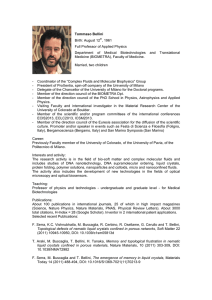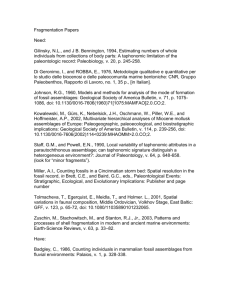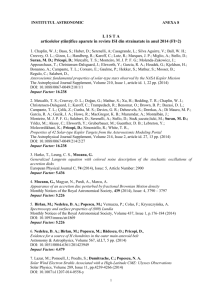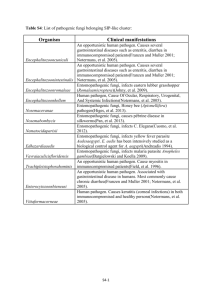Antarctic macrobenthic communities: A compilation of circumpolar information 1
advertisement
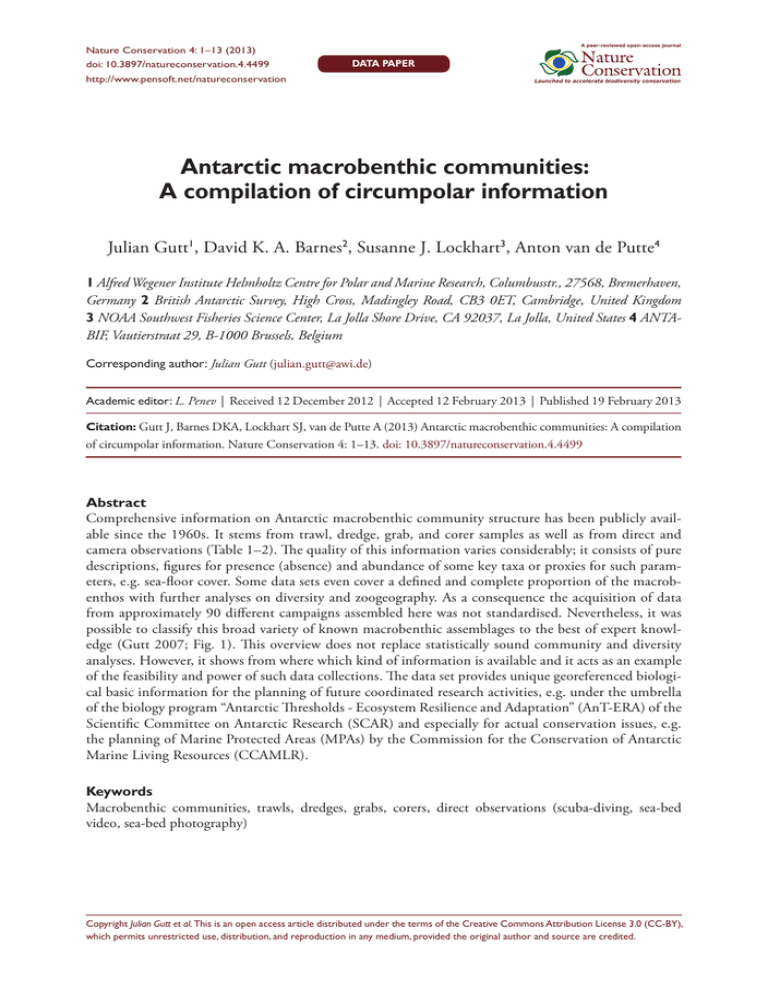
A peer-reviewed open-access journal Nature Conservation 4: 1–13 (2013) Antarctic macrobenthic communities: A compilation of circumpolar information doi: 10.3897/natureconservation.4.4499 Data paper http://www.pensoft.net/natureconservation 1 Launched to accelerate biodiversity conservation Antarctic macrobenthic communities: A compilation of circumpolar information Julian Gutt1, David K. A. Barnes2, Susanne J. Lockhart3, Anton van de Putte4 1 Alfred Wegener Institute Helmholtz Centre for Polar and Marine Research, Columbusstr., 27568, Bremerhaven, Germany 2 British Antarctic Survey, High Cross, Madingley Road, CB3 0ET, Cambridge, United Kingdom 3 NOAA Southwest Fisheries Science Center, La Jolla Shore Drive, CA 92037, La Jolla, United States 4 ANTABIF, Vautierstraat 29, B-1000 Brussels, Belgium Corresponding author: Julian Gutt (julian.gutt@awi.de) Academic editor: L. Penev | Received 12 December 2012 | Accepted 12 February 2013 | Published 19 February 2013 Citation: Gutt J, Barnes DKA, Lockhart SJ, van de Putte A (2013) Antarctic macrobenthic communities: A compilation of circumpolar information. Nature Conservation 4: 1–13. doi: 10.3897/natureconservation.4.4499 Abstract Comprehensive information on Antarctic macrobenthic community structure has been publicly available since the 1960s. It stems from trawl, dredge, grab, and corer samples as well as from direct and camera observations (Table 1–2). The quality of this information varies considerably; it consists of pure descriptions, figures for presence (absence) and abundance of some key taxa or proxies for such parameters, e.g. sea-floor cover. Some data sets even cover a defined and complete proportion of the macrobenthos with further analyses on diversity and zoogeography. As a consequence the acquisition of data from approximately 90 different campaigns assembled here was not standardised. Nevertheless, it was possible to classify this broad variety of known macrobenthic assemblages to the best of expert knowledge (Gutt 2007; Fig. 1). This overview does not replace statistically sound community and diversity analyses. However, it shows from where which kind of information is available and it acts as an example of the feasibility and power of such data collections. The data set provides unique georeferenced biological basic information for the planning of future coordinated research activities, e.g. under the umbrella of the biology program “Antarctic Thresholds - Ecosystem Resilience and Adaptation” (AnT-ERA) of the Scientific Committee on Antarctic Research (SCAR) and especially for actual conservation issues, e.g. the planning of Marine Protected Areas (MPAs) by the Commission for the Conservation of Antarctic Marine Living Resources (CCAMLR). Keywords Macrobenthic communities, trawls, dredges, grabs, corers, direct observations (scuba-diving, sea-bed video, sea-bed photography) Copyright Julian Gutt et al. This is an open access article distributed under the terms of the Creative Commons Attribution License 3.0 (CC-BY), which permits unrestricted use, distribution, and reproduction in any medium, provided the original author and source are credited. 2 Julian Gutt et al. / Nature Conservation 4: 1–13 (2013) Data resources Data published through GBIF: http://ipt.biodiversity.aq/resource.do?r=macrobenthos Seabed images through Pangaea: http://www.pangaea.de/ (sample: http://doi. pangaea.de/10.1594/PANGAEA.702075) General description Additional information: Additional files uploaded: list of references (Table 1–2) and classification of macrobenthic communities (Fig. 1). Project details Project title: Antarctic macrobenthic communities: A compilation of circumpolar information. Personnel: Julian Gutt. Taxonomic coverage General taxonomic coverage description (for detailed information see references in Table 1): Macrobenthic communities have been uploaded in the category “vernacularNames”, abbreviations in “taxonRemarks”. “Sessile suspension feeders and associated fauna” can be dominated by both demosponges, e.g., Cinachyra or Mycale and hexactinellid (glass) sponges. The most common genus is Rossella. The sponges include fast growing genera, such as Homaxinella or those that grow slowly, at least during the adult life stage, such as the also common hexactinellid genus Anoxycalix. The associated fauna comprises specialised predators, such as nudibranches, asteroids (especially Acodontaster conspicuous and Perknaster fuscus, which control fast growing Mycale acerata populations) and gastropods. Other fauna groups are symbionts, amphipods and other macroorganisms that prefer an epibiotic life-mode (mainly from the echinoderms, such as sedentary holothurians, ophiuroids and crinoids). If space is not monopolised by sponges, then, cnidarians (such as gorgonians, pennatularians, alconarians or hydrocorals), solitary and compound ascidians, and a variety of bryozoans can be most abundant. A recently described population of lithodid crabs is speculated to grow fast due to oceanic warming and was associated with the “mobile deposit feeders, infauna and grazers”. Other mobile epifauna assemblages can be dominated in shallow areas by the asteroid Acodontaster validus, by two species of the grazing echinoid Sterechinus, a variety of deposit feeding and scavenging ophiuroids and mobile holothurians. The infauna is comparably rare; however, polychaetes and the clams Yoldia as well as Laternula can reach high densities, especially in shallow muddy sediments. A Antarctic macrobenthic communities: A compilation of circumpolar information 3 general depth gradient exists for biomass and abundances. In addition, very low biomass and abundances are found in shallow habitats that are physically and permanently disturbed by sea-scour, in intermediately deep shelf areas that are scoured by icebergs and in extremely oligotrophic situations under or close to the ice-shelves. Intensively disturbed assemblages can be dominated by very few species, appearing to be almost "monospecific", during recolonisation by pioneers such as the ascidian Mogula pedunculata, bryozonas like Cellarinella and Cellaria or the gorgonian Primnoisis antarctica or in physically disturbed areas, where only opportunistic mobile species survive. Locally clams of the species Adamussium colbecki can live in several layers on top of each other simply due to suitable environmental conditions and low competition. Species can also become very abundant when they are better local competitors for space, such as the demosponge Cinachyra barbata, s.l. Recently, fauna-rich vent sites and far poorer seeps have been discovered. Common names: sessile suspension feeders and associated fauna (SSFA), sessile suspension feeders and associated fauna - predator driven (SSFA-PRED), sessile suspension feeders and associated fauna - dominated by sponges (SSFA-SPO), sessile suspension feeders and associated fauna - dominated by taxa other than sponges (SSFA-OTH), mixed assemblage (MIX), very low biomass or absence of trophic guilds (VLB), “monospecific” (MONO), physically controlled (PHYCO), mobile deposit feeders, infauna and grazers (MOIN), mobile deposits feeders, infauna and grazers - infauna dominated (MOIN-INF), mobile deposit feeders, infauna and grazers - epifauna dominated (MOIN-EPI), vent (VENT), and seep (SEEP). Spatial coverage General spatial coverage: The study area generally covers almost the entire Southern Ocean, including single ice-shelf covered sites (Fig. 2). The vast majority of information is from shelf areas around the continent at water depth shallower than 800m. Non-ice shelf covered shelf areas can be up to 300km wide or the shelf-edge at 600 to 800m depth can “disappear” beneath the floating ice-shelf. Shallow areas (<50m) are rare because 86% of the coast-line is glaciated or consists of an ice-shelf edge. A non-glaciated coast mainly exists along the Antarctic Peninsula. The coastline is either extremely complex with bays, channels, peninsulas, islands etc. or less structured, especially where it is formed by the ice-shelf. Overdeepened basins (inner-shelf depressions) can reach >1200m water depth. Most islands exist west of the Antarctic Peninsula and along the Scotia Arc linking the Peninsula with the southern tip of South America. The coastal waters are mainly affected by the Antarctic Coastal Current (East Wind Drift), whilst the largest off-shore part of the Southern Ocean is dominated by the Antarctic Circumpolar Current (West Wind Drift) with gyres of different size. Sediments are predominantly poorly sorted but also cobble “fields”, bedrock, and pure soft sediments exist. The Antarctic marine ecosystem is shaped by a distinct seasonality of the sea-ice cover affecting a short and intensive primary production in austral summer, by predominantly stable low temperature to which most organisms are thought 4 Julian Gutt et al. / Nature Conservation 4: 1–13 (2013) to be specifically adapted to, and very little terrestrial run-off. Most of the shelf-inhabiting macrobenthic species are endemic; some taxa reach above-average species richness (Clarke and Johnston 2003). Only few marine habitats are protected, most of which are small. Plans and proposals for large Marine Protected Areas (MPA’s), e.g. in East Antarctica, in the Ross and Weddell Seas, exist but require good scientific knowledge and data to be meaningful. Coordinates: 83°0'0"S and 52°0'0"S Latitude; 180°0'0"W and 180°0'0"E Longitude. Temporal coverage: March 1, 1956–February 21, 2010. Methods Method step description: Attribution of the information from the different sources (for references see Table 1, for hyperlinks see Table 2) to the classified macrobenthic assemblages (Fig. 1) was done to the best of expert knowledge. This was done for the entire data set simultaneously and the results were made publically available for the first time via the database “Antarctic Biodiversity Facility” (ANTABIF). The principal parameter on which theses assumptions have been made was biomass or a proxy for biomass such as sea-floor coverage. Some information on benthic functioning is also included directly or indirectly, e.g. predation, competition, succession after iceberg scouring, epi-biotic life-mode and oligotrophic conditions under ice shelves. The source publications listed (Table 1) comprise descriptions of catches, other observations, and data on fauna and were mainly from historical and modern peer-reviewed articles. Other information sources were sea-bed videos and still images together with associated meta-data (Table 2). All the latter source material has an associated DOI and is available at the database PANGAEA (www.pangaea.de). Study extent description: Southern Ocean with emphasize on coastal shelf areas and some islands without specific temporal patterns of sampling. Sampling description: This project aggregates data from various expeditions with a full range of benthic sampling methods, such as grabs, corers, dredges, and trawls as well as non-invasive observations by scuba divers, stationary, towed, or ROV-based still and video-cameras. For detail descriptions see original publications in journals (Table 1) or data repositories (Table 2). Quality control description: A first version of the classification of the macrobenthic communities had been published in a peer-reviewed journal (Gutt 2007). A modified version had been published in the Antarctic Climate Change and the Environment report (ACCE, Turner et al. 2009). The actual version is depicted in Fig. 1. Data presented here is available at ANTABIF/SCAR-MarBIN and will contribute to the biogeographic atlas project of SCAR and the Census of Marine Life (De Broyer et al. in prep.), http://atlas.biodiversity.aq/). Antarctic macrobenthic communities: A compilation of circumpolar information 5 Table 1. References of results and data used for the compilation of information on Antarctic macrobenthic communities presented in this article. Arnaud P (1974) Contribution a la bionomie marine benthique des régions antarctiques et subantarctiques. Téthys 6: 1–464. Azam F, Beers JR, Campbell L, Carlucci AF, Holm-Hansen O, Reis FMH, Karl DM (1979) Occurrence and metabolic activity of organisms under the Ross Ice Shelf, Antarctica, at station J9. Science 203: 451–453. Bannasch R, Feiler K, Rauschert M (1984) Fortsetzung der biologischen Untersuchungen im Gebiet der sowietischen Antarktisstation Bellingshausen. Geodätische und geophysikalische Veröffentlichungen, Reihe 1, Heft 11: 37–55. Barnes DKA (1995a) Sublittoral epifaunal communities at Signy Island, Antarctica. I. The ice-foot zone. Marine Biology 121: 555–563. Barnes DKA (1995b) Sublittoral epifaunal communities at Signy Island, Antarctica. II. Below the icefoot zone. Marine Biology 121: 565–572. Barnes DKA, Clarke A (1995) Epibiotic communities on sublittoral macroinvertebrates at Signy Island, Antarctica. Journal of the Marine Biological Association of the United Kingdom 75: 689–703. Barry JP, Dayton PK (1988) Current patterns in McMurdo Sound, Antarctica and their relationship to local biotic communities. Polar Biology 8: 367–376. Barthel D, Gutt J (1992) Sponge associations in the eastern Weddell Sea. Antarctic Science 4: 137–150. Beaman RJ, O’Brien PE (2009) Collaborative East Antarctic Marine Census (CEAMARC): Post-Survey Report, RSV Aurora Australis Voyage 3, December 2007 - January 2008. Geoscience Australia Record 2008/05, 61 pp. Bellisio NB, Lopez RB, Tomo AP (1972) Distribucion vertical de la fauna benthonica en tres localidades antarticas: Bahia Esperanza, Isla Petermann y Archipelago Melchior. Contribucion Instituto Antarctico Argentino 142: 1–89. Belyaev GM, Ushakov PV (1957) Certain regularities in the quantitative distribution of the bottom fauna in Antarctic waters. Doklady Akademii Nauk SSSR 112: 137–140. Bowden DA, Schiaparelli S, Clark MR, Rickard GJ (2011) A lost world? Archaic crinoid-dominated assemblages on an Antarctic seamount. Deep-Sea Research II 58: 119–127. Bruchhausen PM, Raymond JA, Jacobs SS, DeVries AL, Thorndike EM, DeWitt HH (1979) Fish, crustaceans, and the sea floor under the Ross Ice Shelf. Science 203: 449–451. Bullivant JS (1967) Ecology of the Ross Sea benthos. Bulletin of the New Zealand Department of Scientific and Industrial Research 176: 49–78. Castellanos ZJA de (1973) Estratificacion del complejo benthonico de invertebrados en Puerto Paraiso (Antartida). Contribucion del Instituto Antarctico Argentino 164: 4–23. Cattaneo-Vietti R, Chiantore M, Albertelli G (1997) The population structure and ecology of the Antarctic scallop Adamussium colbecki (Smith, 1902) at Terra Nova Bay (Ross Sea, Antarctica). Scientia Marina, Supl. 2: 15–24. Cattaneo-Vietti R, Chiantore M, Gambi MC, Albertelli G, Cormaci M, Di Geronimo I (2000a) Spatial and vertical distribution of benthic littoral communities in Terra Nova Bay. In: Faranda FM, Guglielmo L, Ionora A (Eds) Ross Sea Ecology. Springer, Berlin, 503–514. Cattaneo-Vietti R, Bavestrello G, Cerrano C, Gaino E, Mazzella L, Pansini M, Sarà M (2000b) The role of sponges in the Terra Nova Bay ecosystem. In: Faranda FM, Guglielmo L, Ionora A (Eds) Ross Sea Ecology. Springer, Berlin, 539–549. Cerrano C, Bavestrello G, Calcinai B, Cattaneo-Vietti R, Sarà A (2000) Asteroids eating sponges from Tethys Bay, East Antarctica. Antarctic Science 12: 425–426. Chiantore M, Cattaneo-Vietti R, Berkman PA, Nigro M, Vacchi M, Schiaparelli H, Albertelli G (2001) Antarctic scallop (Adamussium colbecki) spatial population variability along the Victoria Land Coast, Antarctica. Polar Biology 24: 139–143. Cranmer TL, Ruhl HA, Baldwin RJ, Kaufmann RS (2003) Spatial and temporal variation in the abundance, distribution and population structure of epibenthic megafauna in Port Foster, Deception Island. Deep-Sea Research II 50: 1821–1842. 6 Julian Gutt et al. / Nature Conservation 4: 1–13 (2013) Davis RW, Castellini MA, Horning M, Davis MP (1983) Maintenance of an observation hole through the McMurdo Ice Shelf for winter oceanography. Antarctic Journal of the United States 18: 12–14. Dayton PK (1979) Observations on growth, dispersal and population dynamics of some sponges in McMurdo Sound, Antarctica. Colloques internationaux du Centre national de la recherche scientifique 291: 271–282. Dayton PK, Oliver JS (1977) Antarctic soft-bottom benthos in oligotrophic and eutrophic environments. Science 197: 55–58. Dayton PK, Kooyman GL, Barry JP (1984) Benthic life under thick ice. Antarctic Journal of the United States 19: 128. Dayton PK, Robillard GA, Paine RT (1970) Benthic faunal zonation as a result of anchor ice at McMurdo Sound Antarctica. In: Holdgate MW (Ed) Antarctic Ecology. Academic Press, New York, 244–258. Dayton PK, Robilliard GA, Paine RT, Dayton LB (1974) Biological accommodation in the benthic community at McMurdo Sound, Antarctica. Ecological Monographs 44: 105–128. Domack E, Ishman S, Leventer A, Sylva S, Willmott V, Huber B (2005) A chemotrophic ecosystem found beneath Antarctic ice shelf. EOS 86 (269): 271–272. Drescher HE, Hubold G, Piatkowski U, Plötz J, Voß J (1983) Das biologische Programm der ANTARKTIS-I-Expedition mit FS “Polarstern”. Reports on Polar Research 12: 1–34. Everitt DA, Poore GCB, Pickard J (1980) Marine benthos from Davis Station, east Antarctica. Australian Journal of Freshwater Research 31: 829–836. Gallardo VA, Castillo JG, Retamal MA, Yáñez A, Moyano HI, Hermosilla JG (1977) Quantitative studies on the soft-bottom macrobenthic animal communities of shallow Antarctic bays. In: Llano GA (Ed) Adaptations within Antarctic ecosystems. Smithsonian Institution, Washington, DC, 361–387. Gerdes D, Klages M, Arntz WE, Herman RL, Galéron J, Hain S (1992) Quantitative investigations on macrobenthos communities of the southeastern Weddell Sea shelf based on multibox corer samples. Polar Biology 12: 291–301. Gruzov EN, Pushkin AF (1970) Bottom communities of the upper sublittoral of Enderby Land and the South Shetlands. In: Holdgate MW (Ed) Antarctic Ecology, Vol. 1., Academic Press, London, 235–238. Gruzov EN, Propp MV, Pushkin AF (1968) Biological associations of coastal areas of the Davis Sea (based on the observations of divers). Soviet Antarctic Expedition Information Bulletin 6(6): 523–533. Gutt J, Piepenburg D (1991) Dense aggregations of deep-sea holothurians in the southern Weddell Sea, Antarctica. Marine Ecology Progress Series 68: 277–285. Gutt J, Starmans A (1998) Structure and biodiversity of megabenthos in the Weddell and Lazarev Seas (Antarctica): ecological role of physical parameters and biological interactions. Polar Biology 20: 229–247. Gutt J (2007) Antarctic macro-zoobenthic communities: a review and an ecological classification. Antarctic Science 19: 165–182. Gutt J, Koubbi P, Eléaume M (2007) Mega-epibenthic diversity off Terre Adélie (Antarctica) in relation to disturbance. Polar Biology 30: 1323–1329. Gutt J, Barratt I, Domack E, d›Udekem d›Acoz C, Dimmler W, Grémare A, Heilmayer O, Isla E, Janussen D, Jorgensen E, Kock K-H, Lehnert LS, López-Gonzáles P, Langner S, Linse K, ManjónCabeza ME, Meißner M, Montiel A, Raes M, Robert H, Rose A, Sañé-Schepisi E, Saucède T, Scheidat M, Schenke H-W, Seiler J, Smith C (2010) Biodiversity change after climate-induced ice-shelf collapse in the Antarctic. Deep-Sea Research II 58: 74–83. Hamada E, Numanami H, Naito Y, Taniguchi A (1986) Observation on the marine benthic organisms at Syowa Station in Antarctica using a remotely operated vehicle. Memoirs of National Institute of Polar Research (Japan) 40: 289–298. Jazdzewski K, Juraz W, Kittel W, Presler E, Presler P, Sicinski J (1986) Abundance and biomass estimates of the benthic Fauna in Admiralty Bay, King George Island, South Shetland Islands. Polar Biology 6: 5–16. Jazdzewski K, De Broyer C, Pudlarz M, Zielinski D (2001) Seasonal fluctuations of vagile benthos in the uppermost sublittoral of a maritime Antarctic fjord. Polar Biology 24: 910–917. Jones CD, Lockhart SJ (2011) Detecting Vulnerable Marine Ecosystems in the Southern Ocean using research trawls and underwater imagery. Marine Policy 35(5): 7732–736. Antarctic macrobenthic communities: A compilation of circumpolar information 7 Jones DOB (2005) Ecological controls on density, diversity and community structure of polar megabenthos. PhD thesis, Southampton, UK: University of Southampton. Kirkwood JM, Burton HR (1988) Macrobenthic species assemblages in Ellis Fjord, Vestfold Hills, Antarctica. Marine Biology 97: 445–457. Kohnen H (1984) Die Expedition ANTARKTIS-II mit FS ‘Polarstern’ 1983/84. Reports on Polar Research 19: 1–185. Lipps JH, Ronan TE Jr, DeLaca TE (1979) Life below the Ross Ice Shelf, Antarctica. Science 203: 447–449. Littlepage JL, Pearse JS (1962) Biological and oceanographic observations under an Antarctic ice shelf. Science 137: 679–681. Lockhart SJ, Jones CD (2008) Biogeographic patterns of benthic invertebrate megafauna on shelf areas within the Southern Ocean Atlantic sector. CCAMLR Science 15: 167–192. Lovell LL, Trego KD (2003) The epibenthic megafaunal and benthic infaunal invertebrates of Port Foster, Deception Island (South Shetland Islands, Antarctica). Deep-Sea Research II 50: 1799–1819. Lowry JK (1975) Soft bottom macrobenthic community of Arthur Harbor, Antarctica. Antarctic Research Series 23: 1–19. Nakajima Y, Watanabe K, Naito Y (1982) Diving observations of the marine benthos at Syowa station, Antarctica. Memoirs of the National Institute of Polar Research (Japan), Special Issue 23: 44–54. Niemann H, Fischer D, Graffe D, Knittel K, Montiel A, Heilmayer O, Nöthen K, Pape T, Kasten S, Bohrmann G, Boetius A, Gutt J (2009) Biogeochemistry of a low-activity cold seep in the Larsen B area, western Weddell Sea, Antarctica. Biogeosciences 6: 2383–2395. Oliver JS, Slattery PN (1985) Effects of crustacean predators on species composition and population structure of soft-bodied infauna from McMurdo Sound, Antarctica. Ophelia 24: 155–175. Oliver JS, Watson DJ, O›Connor EF, Dayton PK (1976) Benthic communities of McMurdo Sound. Antarctic Journal of the U.S. 11: 58–549. Pabis K, Sicinski J, Krymarys M (2011) Distribution patterns in the biomass of macrozoobenthic communities in Admiralty Bay (King George Island, South Shetlands, Antarctic). Polar Biology 34: 489–500. Piepenburg D, Voß J, Gutt J (1997) Assemblages of sea stars (Echinodermata: Asteroidea) and brittle stars (Echinodermata: Ophiuroidea) in the Weddell Sea (Antarctica) and off Northeast Greenland (Arctic): a comparison of diversity and abundance. Polar Biology 17: 305–322. Post AL, Hemer MA, O›Brien PE, Roberts D, Craven M (2007) History of benthic colonisation beneath the Amery Ice Shelf, East Antarctica. Marine Ecology Progress Series 344: 29–37. Post AL, O›Brien PE, Beaman RJ, Riddle MJ, de Santis L (2010a) Physical controls on deep water coral communities on the George V Land slope, East Antarctica. Antarctic Science 22: 371–378. Post AL, Beaman RJ, O›Brien PE, Eléaume M, Riddle MJ (2011) Community structure and benthic habitats across the George V Shelf, East Antarctica: trends through space and time. Deep-Sea Research II 58: 105–118. Propp MV (1977) The study of bottom fauna at Haswell Island by scuba diving. In: Holdgate MW (Ed) Antarctic Ecology, Vol. 1., Academic Press, London, 239–241. Raguá-Gil JM, Gutt J, Clarke A, Arntz WE (2004) Antarctic shallow-water mega-epibenthos: shaped by circumpolar dispersion or local conditions? Marine Biology 144: 829–839. Rehm P, Hooke RA, Thatje S (2011) Macrofaunal communities on the continental shelf off Victoria Land, Ross Sea, Antarctica. Antarctic Science 23: 449–455. Riddle MJ, Craven M, Goldsworthy PM, Carsey F (2007) A diverse benthic assemblage 100 km from open water under the Amery Ice Shelf, Antarctica. Paleoceanography 22, doi: 10.1029/2006PA001327 Rogers AD, Tyler PA, Connelly DP, Copley JT, James R, Larter RD, Linse K, Mills RA, Naveira Garabato A, Pancost RD, Pearce DA, Polunin NVC, German CR, Shank T, Boersch-Supan PH, Alker BJ, Aquilina A, Bennett SA, Clarke A, Dinley RJJ, Graham AGC, Green DRH, Hawkes JA, Hepburn L, Hilario A, Huvenne VAI, Marsh L, Ramirez-Llodra E, Reid WDK, Roterman CN, Sweeting CJ, Thatje S, Zwirglmaier K (2012) The discovery of new deep-sea hydrothermal vent communities in the Southern Ocean and implications for biogeography. PLoS Biology 10(1): e1001234. doi: 10.1371/journal.pbio.1001234 Sahade R, Tatián M, Kowalke J, Kühne S, Esnal GB (1998) Benthic faunal associations on soft substrates at Potter Cove, King George Island, Antarctic. Polar Biology 19: 85–91. 8 Julian Gutt et al. / Nature Conservation 4: 1–13 (2013) Saiz JI, García FJ, Manjón-Cabeza ME, Parapar J, Peña-Cantero A, Saucède T, Troncoso JS, Ramos A (2008) Community structure and spatial distribution of benthic fauna in the Bellingshausen Sea (West Antarctica). Polar Biology 31: 735–743 (only stations <1000m considered). Sicinski J, Pabis K, Jazdzewski K, Konopacka A, Blazewicz-Paszkowycz M (2011) Macrobenthos of two Antarctic glacial covres: a comparison with non-disturbed bottom areas. Polar Biology 35: 355–367. Smith CR, Grange LJ, Honig DL, Naudts L, Huber B, Guidi L, Domack E (2012) A large population of king crabs in Palmer Deep on the west Antarctic Peninsula shelf and potential invasive impacts. Proceedings of the Royal Society B, Biological Sciences 279: 1017–1026. Starmans A, Gutt J, Arntz WE (1999) Mega-epibenthic communities in Arctic and Antarctic shelf areas. Marine Biology 135: 269–280. Teixidó N, Garrabou J, Arntz WE (2002) Spatial pattern quantification of Antarctic benthic communities using landscape indices. Marine Ecology Progress Series 242: 1–14. Sumida PYG, Bernardino AF, Stedall VP, Glover AG, Smith CR (2008) Temporal changes in benthic megafaunal abundance and composition across the West Antarctic Peninsula shelf: Results from video surveys. Deep-Sea Research II 55: 2465–2477. Teixidó N, Garrabou J, Gutt J, Arntz WE (2004) Recovery in Antarctic benthos after iceberg disturbance: trends in benthic composition, abundance, and growth forms. Marine Ecology Progress Series 278: 1–16. Teixidó N, Garrabou J, Gutt J, Arntz WE (2007) Iceberg disturbance and successional spatial patterns: the case of the shelf Antarctic benthic communities. Ecosystems 10: 142–157. Voß J (1988) Zoogeographie und Gemeinschaftsanalyse des Makrozoobenthos des Weddellmeeres (Antarktis). Berichte zur Polarforschung 45: 1–145. Watters G, Bergström B, Gutt J, Petterson J-O, Rosenberg J, Setran A, Valenzuela C (1995) 9. Leg III: Crab and epifaunal surveys of bays, anchorages, and fjords around South Georgia. AMLR 1994/95 Field Season Report, Administrative Report LJ-95–13, National Oceanic and Atmospheric Administration, Southwest Fisheries Science Center, Antarctic Ecosystem Research Group, 113–130. Zamorano JH (1983) Zonación y Biomasa de la macrofauna bentónica en Bahía South, Archipiélago de Palmer, Antártica. Serie cientifica. Instituto Antarctico Chileno 30: 27–38. Table 2. Hyperlinks (DataCite DOIs), which provide access to seabed images and metadata from single stations where the images have been taken. The macrobenthos depicted in these images was classified and used for the compilation of information on Antarctic macro-benthic communities presented in this article. doi: 10.1594/PANGAEA.702075 doi: 10.1594/PANGAEA.702059 doi: 10.1594/PANGAEA.702076 doi: 10.1594/PANGAEA.702077 doi: 10.1594/PANGAEA.702062 doi: 10.1594/PANGAEA.702078 doi: 10.1594/PANGAEA.702064 doi: 10.1594/PANGAEA.702065 doi: 10.1594/PANGAEA.702066 doi: 10.1594/PANGAEA.702067 doi: 10.1594/PANGAEA.702079 doi: 10.1594/PANGAEA.702069 doi: 10.1594/PANGAEA.702070 doi: 10.1594/PANGAEA.702080 doi: 10.1594/PANGAEA.702072 doi: 10.1594/PANGAEA.702073 doi: 10.1594/PANGAEA.702074 doi: 10.1594/PANGAEA.770359 doi: 10.1594/PANGAEA.198690 doi: 10.1594/PANGAEA.198691 doi: 10.1594/PANGAEA.198692 doi: 10.1594/PANGAEA.198693 doi: 10.1594/PANGAEA.198694 doi: 10.1594/PANGAEA.198695 doi: 10.1594/PANGAEA.198696 doi: 10.1594/PANGAEA.198697 doi: 10.1594/PANGAEA.198698 doi: 10.1594/PANGAEA.198699 doi: 10.1594/PANGAEA.198667 doi: 10.1594/PANGAEA.198668 doi: 10.1594/PANGAEA.198669 doi: 10.1594/PANGAEA.198670 doi: 10.1594/PANGAEA.198671 doi: 10.1594/PANGAEA.198672 Antarctic macrobenthic communities: A compilation of circumpolar information doi: 10.1594/PANGAEA.198673 doi: 10.1594/PANGAEA.198674 doi: 10.1594/PANGAEA.198675 doi: 10.1594/PANGAEA.198676 doi: 10.1594/PANGAEA.198677 doi: 10.1594/PANGAEA.198678 doi: 10.1594/PANGAEA.198679 doi: 10.1594/PANGAEA.198680 doi: 10.1594/PANGAEA.198681 doi: 10.1594/PANGAEA.198682 doi: 10.1594/PANGAEA.206413 doi: 10.1594/PANGAEA.198683 doi: 10.1594/PANGAEA.198684 doi: 10.1594/PANGAEA.198685 doi: 10.1594/PANGAEA.198686 doi: 10.1594/PANGAEA.198687 doi: 10.1594/PANGAEA.198688 doi: 10.1594/PANGAEA.198689 doi: 10.1594/PANGAEA.250203 doi: 10.1594/PANGAEA.250204 doi: 10.1594/PANGAEA.250205 doi: 10.1594/PANGAEA.250206 doi: 10.1594/PANGAEA.250207 doi: 10.1594/PANGAEA.250208 doi: 10.1594/PANGAEA.250209 doi: 10.1594/PANGAEA.250210 doi: 10.1594/PANGAEA.250211 doi: 10.1594/PANGAEA.250212 doi: 10.1594/PANGAEA.250213 doi: 10.1594/PANGAEA.250214 doi: 10.1594/PANGAEA.250215 doi: 10.1594/PANGAEA.250216 doi: 10.1594/PANGAEA.250217 doi: 10.1594/PANGAEA.250218 doi: 10.1594/PANGAEA.250219 doi: 10.1594/PANGAEA.198643 doi: 10.1594/PANGAEA.198646 doi: 10.1594/PANGAEA.198644 doi: 10.1594/PANGAEA.198645 doi: 10.1594/PANGAEA.198647 doi: 10.1594/PANGAEA.198648 doi: 10.1594/PANGAEA.198649 doi: 10.1594/PANGAEA.198650 doi: 10.1594/PANGAEA.198653 doi: 10.1594/PANGAEA.198654 doi: 10.1594/PANGAEA.198656 doi: 10.1594/PANGAEA.198657 doi: 10.1594/PANGAEA.198655 doi: 10.1594/PANGAEA.198658 doi: 10.1594/PANGAEA.198659 doi: 10.1594/PANGAEA.198660 doi: 10.1594/PANGAEA.198661 doi: 10.1594/PANGAEA.198662 doi: 10.1594/PANGAEA.198663 doi: 10.1594/PANGAEA.198664 doi: 10.1594/PANGAEA.198665 doi: 10.1594/PANGAEA.198666 doi: 10.1594/PANGAEA.757741 doi: 10.1594/PANGAEA.757740 doi: 10.1594/PANGAEA.227308 doi: 10.1594/PANGAEA.227309 doi: 10.1594/PANGAEA.227310 doi: 10.1594/PANGAEA.227311 doi: 10.1594/PANGAEA.666972 doi: 10.1594/PANGAEA.666973 doi: 10.1594/PANGAEA.666974 doi: 10.1594/PANGAEA.666975 doi: 10.1594/PANGAEA.666976 doi: 10.1594/PANGAEA.666977 doi: 10.1594/PANGAEA.666978 doi: 10.1594/PANGAEA.666979 doi: 10.1594/PANGAEA.666980 doi: 10.1594/PANGAEA.666981 doi: 10.1594/PANGAEA.666982 doi: 10.1594/PANGAEA.666983 doi: 10.1594/PANGAEA.666984 doi: 10.1594/PANGAEA.666986 doi: 10.1594/PANGAEA.666991 doi: 10.1594/PANGAEA.666992 doi: 10.1594/PANGAEA.666993 doi: 10.1594/PANGAEA.666994 doi: 10.1594/PANGAEA.666995 doi: 10.1594/PANGAEA.666996 doi: 10.1594/PANGAEA.666997 doi: 10.1594/PANGAEA.227670 doi: 10.1594/PANGAEA.220741 doi: 10.1594/PANGAEA.220742 doi: 10.1594/PANGAEA.220743 doi: 10.1594/PANGAEA.220744 doi: 10.1594/PANGAEA.220745 doi: 10.1594/PANGAEA.220746 doi: 10.1594/PANGAEA.220747 doi: 10.1594/PANGAEA.319912 doi: 10.1594/PANGAEA.319913 9 10 Julian Gutt et al. / Nature Conservation 4: 1–13 (2013) doi: 10.1594/PANGAEA.319914 doi: 10.1594/PANGAEA.319915 doi: 10.1594/PANGAEA.319917 doi: 10.1594/PANGAEA.319918 doi: 10.1594/PANGAEA.319916 doi: 10.1594/PANGAEA.319919 doi: 10.1594/PANGAEA.319920 doi: 10.1594/PANGAEA.319894 doi: 10.1594/PANGAEA.319895 doi: 10.1594/PANGAEA.319896 doi: 10.1594/PANGAEA.319897 doi: 10.1594/PANGAEA.319898 doi: 10.1594/PANGAEA.319899 doi: 10.1594/PANGAEA.319900 doi: 10.1594/PANGAEA.319901 doi: 10.1594/PANGAEA.319902 doi: 10.1594/PANGAEA.319903 doi: 10.1594/PANGAEA.319904 doi: 10.1594/PANGAEA.319905 doi: 10.1594/PANGAEA.319906 doi: 10.1594/PANGAEA.319907 doi: 10.1594/PANGAEA.319908 doi: 10.1594/PANGAEA.319909 doi: 10.1594/PANGAEA.319910 doi: 10.1594/PANGAEA.319888 doi: 10.1594/PANGAEA.319889 doi: 10.1594/PANGAEA.319890 doi: 10.1594/PANGAEA.319891 doi: 10.1594/PANGAEA.319892 doi: 10.1594/PANGAEA.319893 doi: 10.1594/PANGAEA.667009 doi: 10.1594/PANGAEA.667008 doi: 10.1594/PANGAEA.667010 doi: 10.1594/PANGAEA.667011 doi: 10.1594/PANGAEA.667012 doi: 10.1594/PANGAEA.667013 doi: 10.1594/PANGAEA.667014 doi: 10.1594/PANGAEA.667015 doi: 10.1594/PANGAEA.667016 doi: 10.1594/PANGAEA.667017 doi: 10.1594/PANGAEA.667018 doi: 10.1594/PANGAEA.667019 doi: 10.1594/PANGAEA.667020 doi: 10.1594/PANGAEA.667021 doi: 10.1594/PANGAEA.667022 doi: 10.1594/PANGAEA.667023 doi: 10.1594/PANGAEA.667024 doi: 10.1594/PANGAEA.667025 doi: 10.1594/PANGAEA.667026 doi: 10.1594/PANGAEA.667027 doi: 10.1594/PANGAEA.667028 doi: 10.1594/PANGAEA.667029 doi: 10.1594/PANGAEA.667030 doi: 10.1594/PANGAEA.667031 doi: 10.1594/PANGAEA.667032 doi: 10.1594/PANGAEA.691559 doi: 10.1594/PANGAEA.691560 doi: 10.1594/PANGAEA.740036 doi: 10.1594/PANGAEA.691561 doi: 10.1594/PANGAEA.691562 doi: 10.1594/PANGAEA.691563 doi: 10.1594/PANGAEA.691564 doi: 10.1594/PANGAEA.691565 doi: 10.1594/PANGAEA.691566 doi: 10.1594/PANGAEA.691567 doi: 10.1594/PANGAEA.691568 doi: 10.1594/PANGAEA.691569 doi: 10.1594/PANGAEA.691570 doi: 10.1594/PANGAEA.691571 doi: 10.1594/PANGAEA.691572 doi: 10.1594/PANGAEA.691573 doi: 10.1594/PANGAEA.691574 doi: 10.1594/PANGAEA.691575 doi: 10.1594/PANGAEA.691576 doi: 10.1594/PANGAEA.691577 doi: 10.1594/PANGAEA.691578 doi: 10.1594/PANGAEA.691579 doi: 10.1594/PANGAEA.691580 doi: 10.1594/PANGAEA.691581 doi: 10.1594/PANGAEA.691545 doi: 10.1594/PANGAEA.691546 doi: 10.1594/PANGAEA.691547 doi: 10.1594/PANGAEA.691548 doi: 10.1594/PANGAEA.691549 doi: 10.1594/PANGAEA.691550 doi: 10.1594/PANGAEA.691551 doi: 10.1594/PANGAEA.691552 doi: 10.1594/PANGAEA.691553 doi: 10.1594/PANGAEA.691554 doi: 10.1594/PANGAEA.691555 doi: 10.1594/PANGAEA.691556 doi: 10.1594/PANGAEA.691557 doi: 10.1594/PANGAEA.691558 doi: 10.1594/PANGAEA.713323 doi: 10.1594/PANGAEA.713324 doi: 10.1594/PANGAEA.713325 Antarctic macrobenthic communities: A compilation of circumpolar information doi: 10.1594/PANGAEA.713326 doi: 10.1594/PANGAEA.713327 doi: 10.1594/PANGAEA.713328 doi: 10.1594/PANGAEA.713329 11 doi: 10.1594/PANGAEA.713330 doi: 10.1594/PANGAEA.713331 doi: 10.1594/PANGAEA.713332 Figure 1. Classification of Antarctic macro-benthic communities (after Gutt 2007 and Turner et al. 2009). Datasets Dataset description Object name: Darwin Core Archive Antarctic macrobenthic communities: A compilation of circumpolar information Character encoding: UTF-8 Format name: Darwin Core Archive format Format version: 1.0 Distribution: http://ipt.biodiversity.aq/archive.do?r=macrobenthos 12 Julian Gutt et al. / Nature Conservation 4: 1–13 (2013) Figure 2. Geographic coverage of the circumpolar distribution of information on Antarctic macrobenthic communities provided by ANTABIF. Publication date of data: 2012-07-19 Language: English Licenses of use: This data-set is entitled “Antarctic macrobenthic communities: A compilation of circumpolar information” and has been uploaded to (ANTABIF). The data set has been made available under the Open Data Commons Attribution License: http://www.opendatacommons.org/licenses/by/1.0/ Metadata language: English Date of metadata creation: 2012-07-19 Hierarchy level: Dataset Antarctic macrobenthic communities: A compilation of circumpolar information 13 Acknowledgements Thanks are due to all who provided data for this compilation. References De Broyer C, Koubbi P, Danis B, David B, Grant S, Griffiths H, Gutt J, Held C, Huettmann F, Post A, Ropert-Coudert Y (in prep.) The CAML / SCAR-MarBIN Biogeography Atlas of the Southern Ocean. Clarke A, Johnston NM (2003) Antarctic marine benthic diversity. Oceanography and Marine Biology: an Annual Review 41: 47–114. Gutt J (2007) Antarctic macro-zoobenthic communities: a review and an ecological classification. Antarctic Science 9: 165–182. doi: 10.1017/S0954102007000247 Turner J, Bindschadler R, Convey P, di Prisco G, Fahrbach E, Gutt J, Hodgson D, Mayewsky P, Summerhayes C (2009) Antarctic Climate Change and the Environment. SCAR, Scott Polar Research Institute, Cambridge, 526 pp.
